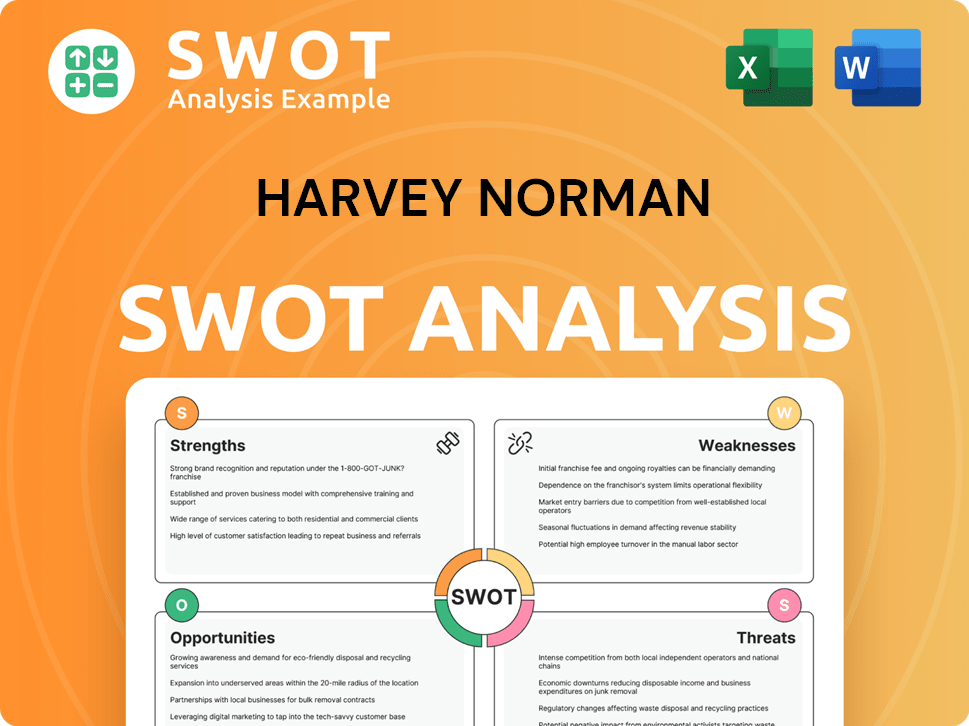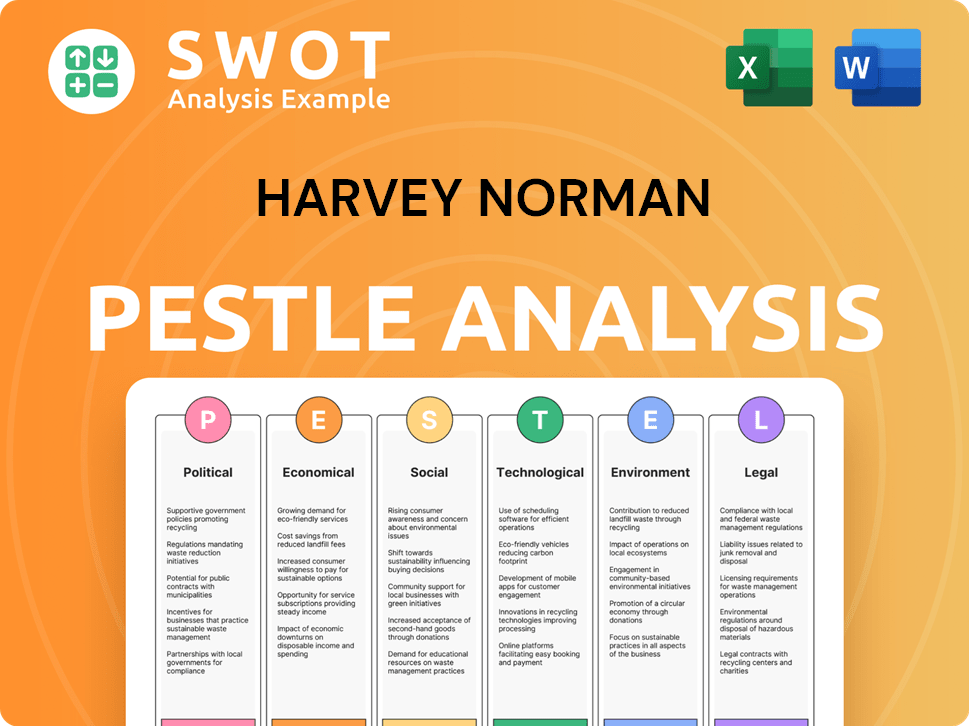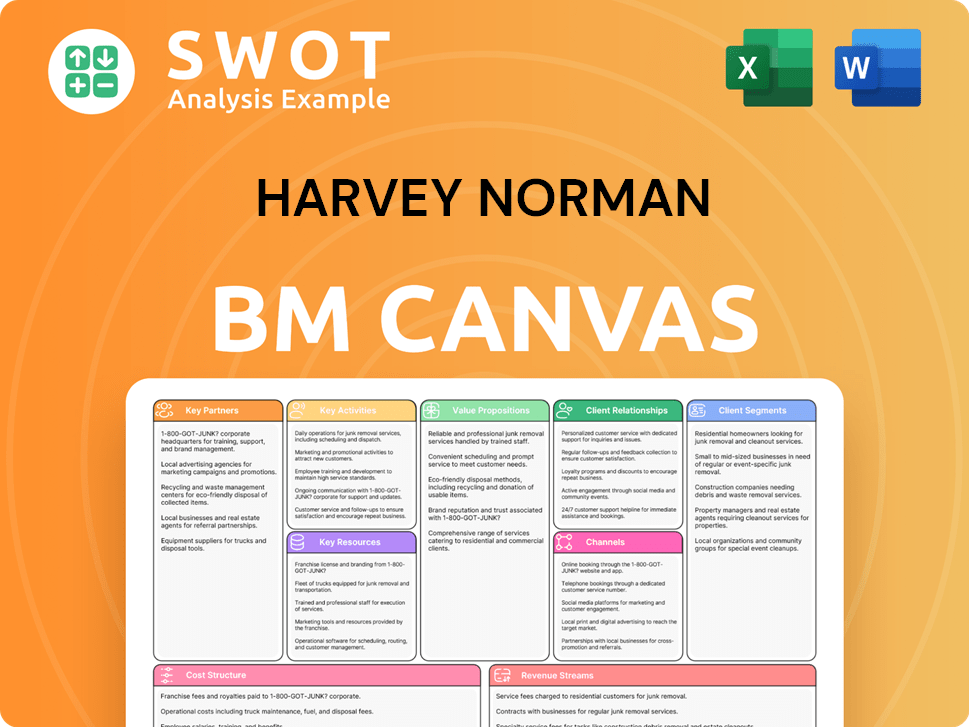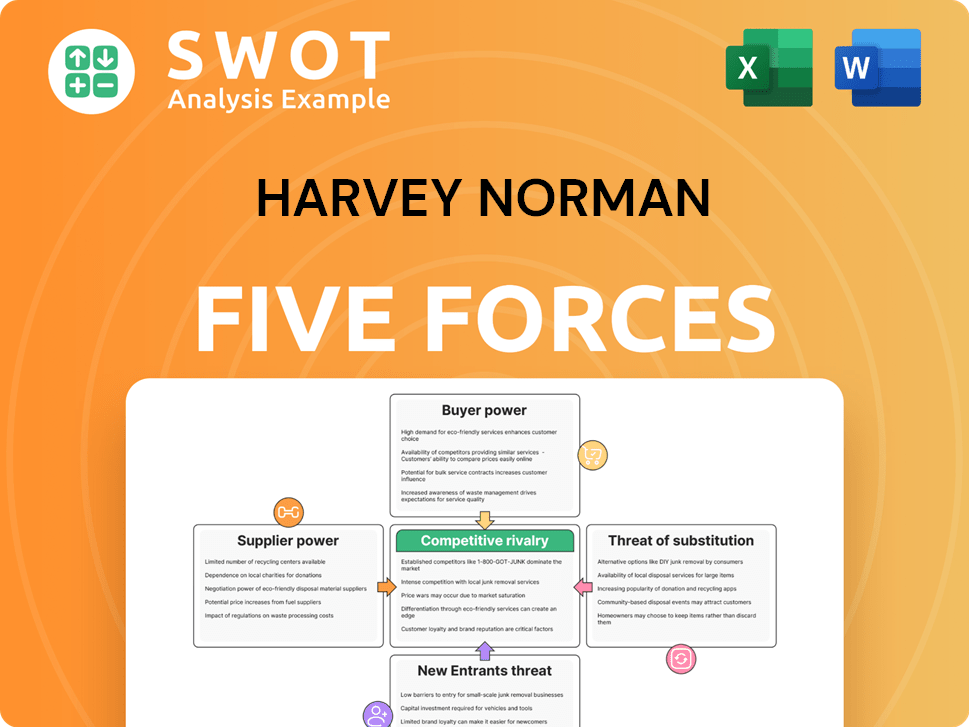Harvey Norman Bundle
Can Harvey Norman Continue Its Retail Reign?
Since its inception in 1982, Harvey Norman has become a retail giant, but can it sustain its success in today's rapidly evolving market? This article examines Harvey Norman's Harvey Norman SWOT Analysis, growth strategy, and future prospects, providing a comprehensive overview for investors and business strategists alike. We'll explore the company's ambitious plans and how it intends to navigate the complexities of the retail industry trends.

To understand Harvey Norman's potential, we'll dissect its market expansion strategies, focusing on its international presence and digital transformation strategy. We'll also analyze its financial performance Harvey Norman, including revenue and profit projections, and assess the potential risks and rewards associated with its long-term strategic goals. This Harvey Norman company analysis will provide valuable insights into its competitive landscape and sustainability initiatives.
How Is Harvey Norman Expanding Its Reach?
The company is actively pursuing growth through strategic international expansion and enhancing its existing retail footprint. This strategy aims to capitalize on new market opportunities and strengthen its position in the retail industry. The focus is on adapting to local market conditions and consumer demands to drive long-term financial performance.
This approach includes opening new stores, strategic property acquisitions, and refurbishments. These initiatives are designed to access new customers and diversify revenue streams. The company's expansion plans are a key component of its overall Harvey Norman growth strategy, positioning it for continued success.
The company's Harvey Norman future prospects are closely tied to its ability to execute these expansion plans effectively. By investing in both physical and digital retail spaces, the company aims to stay ahead of retail industry trends and maintain a competitive edge. The following sections detail specific expansion initiatives.
The company is expanding its global presence, with a strong focus on Southeast Asia and the United Kingdom. This market expansion strategy is a key driver of its growth. The company's international expansion is a significant part of its long-term strategic goals.
New store openings are a core part of the expansion strategy. The company plans to open up to 10 new stores in Malaysia in FY25, aiming for a total of 80 stores by 2028. Two new full-format stores are slated to open in Christchurch, New Zealand, by late 2024.
The UK market is a significant focus, with the opening of the Merry Hill flagship store in October 2024. A second UK store is planned for FY26 in Sutton Coldfield, aiming to capitalize on the West Midlands' population. This expansion is part of the company's broader Harvey Norman company analysis.
Strategic investments in property are crucial. In East Zagreb, Croatia, a new complex is being built, set to open in late 2026. The existing Zagreb flagship is also undergoing a redesign, expected to be completed in 2025. These efforts aim to enhance the customer experience.
The Malaysian flagship relocated to the Mid Valley Mega Mall in October 2024, expanding its footprint to 61,000 square feet. In Australia, FY25 will see the addition of new franchised complexes and relocations. These initiatives are designed to improve financial performance Harvey Norman and adapt to Harvey Norman's competitive landscape analysis.
The company's expansion strategy includes new store openings, strategic property acquisitions, and refurbishments. These initiatives are designed to drive growth and enhance the customer experience. For more information, you can explore the Owners & Shareholders of Harvey Norman.
- New Store Openings: Focus on Malaysia (up to 10 stores in FY25) and New Zealand (two new stores in 2024).
- UK Market Entry: Merry Hill flagship opened in October 2024, with a second store planned for FY26.
- Strategic Property Investments: New complex in Croatia and redesign of existing stores.
- Refurbishments and Relocations: Malaysian flagship relocation to Mid Valley Mega Mall.
Harvey Norman SWOT Analysis
- Complete SWOT Breakdown
- Fully Customizable
- Editable in Excel & Word
- Professional Formatting
- Investor-Ready Format

How Does Harvey Norman Invest in Innovation?
In today's fast-paced retail environment, understanding and adapting to innovation and technology is crucial for sustained growth. The company is actively embracing digital transformation and leveraging cutting-edge technologies to enhance its market position. This approach is designed to meet evolving customer expectations and maintain a competitive edge in the retail industry.
The company is focused on enhancing its online presence and developing innovative digital strategies. This includes supporting its Australian franchisees in implementing an online-to-offline (O2O) strategy. This integrated approach aims to provide a seamless shopping experience, blending the convenience of online shopping with the tangible benefits of physical stores.
The company's strategy involves significant investments in artificial intelligence (AI), particularly in the emerging AI-PC market. The company believes that the continued innovation and widespread adoption of next-generation AI PCs and devices will drive sales growth across various categories. This includes home appliances, television, audio, mobile, and computer technology, with expectations for continued growth through 2025 and beyond.
The company is heavily investing in digital initiatives to improve customer experience and expand its market reach. This includes enhancing its online platform and implementing digital strategies to meet evolving customer needs.
The company is committed to the AI-PC market, anticipating growth in sales of home appliances, television, audio, mobile, and computer technology. This strategic focus is expected to drive sales growth in 2025 and beyond.
The company is exploring augmented reality (AR) applications to personalize online purchases. This initiative aims to enhance the online shopping experience and make it more engaging for customers.
The company is investing in automated logistics and warehouse systems to improve inventory management and reduce delivery times. This investment is crucial for ensuring product availability and enhancing customer satisfaction.
The company is modernizing its physical stores to create enhanced digital experiences. This includes major redesigns in locations like Zagreb, Croatia, to provide a more engaging and technologically advanced shopping environment.
The company is assisting its Australian franchisees in implementing an online-to-offline (O2O) strategy. This approach integrates online and offline channels to provide a seamless shopping experience for customers.
The company's investment in automated logistics and efficient warehouse systems is designed to improve inventory management and reduce delivery times. This focus on supply chain optimization is critical for ensuring product availability and meeting customer expectations. The company's modernization initiatives also extend to its physical stores, with significant redesigns in locations like Zagreb, Croatia, to enhance digital experiences. For more insights, you can read about the Target Market of Harvey Norman.
The company's strategy includes significant investments in technology to drive growth and enhance customer experience. These investments are focused on digital transformation, AI, and supply chain optimization.
- AI and AI-PC Market: Investing in AI to capitalize on the growth of AI-powered devices.
- Digital Transformation: Enhancing online presence and implementing digital strategies.
- Automated Logistics: Improving inventory management and reducing delivery times.
- Store Modernization: Redesigning physical stores to create enhanced digital experiences.
Harvey Norman PESTLE Analysis
- Covers All 6 PESTLE Categories
- No Research Needed – Save Hours of Work
- Built by Experts, Trusted by Consultants
- Instant Download, Ready to Use
- 100% Editable, Fully Customizable

What Is Harvey Norman’s Growth Forecast?
The financial outlook for Harvey Norman reflects a positive trajectory, particularly in the first half of FY25. The company's Harvey Norman growth strategy has shown resilience, with a significant increase in profit before tax (PBT). This performance is underpinned by robust sales from franchisees and consistent demand across key product categories, indicating a healthy market position.
Total system sales revenue reached $4.83 billion during this period, demonstrating the scale of operations. The company's net assets have also grown, reaching $4.72 billion, with a 7.5% compound annual growth rate over five years. Furthermore, the total assets exceeded $8 billion for the first time, reaching $8.25 billion as of December 31, 2024, showcasing substantial financial strength.
Harvey Norman's financial stability is further highlighted by its low net debt-to-equity ratio, which stood at 12.01% as of December 2024, down from 14.49% in June 2024. This suggests a well-managed balance sheet and a solid foundation for future growth. For more insights into the company's values, you can read the Mission, Vision & Core Values of Harvey Norman.
Profit Before Tax (PBT) increased by 41.2% to $400.3 million in the first half of FY25. This growth indicates a strong recovery and improved profitability compared to the previous year. The increase was driven by strong franchisee sales and stable demand.
Total system sales revenue reached $4.83 billion in the first half of FY25. This figure includes both Australian franchisee sales and overseas company-operated sales. The revenue demonstrates the company's substantial market presence and sales volume.
Net assets grew to $4.72 billion, reflecting a 7.5% compound annual growth rate over five years. Total assets reached $8.25 billion as of December 31, 2024. This growth indicates the company's financial health and expansion.
The net debt-to-equity ratio was maintained at a low 12.01% as of December 2024, down from 14.49% in June 2024. This demonstrates effective debt management and a strong financial position. The low ratio indicates a conservative approach to financial leverage.
Analysts anticipate a rebound in sales and earnings from fiscal 2025, supported by global consumer demand. Factors such as lower interest rates, tax cuts, and energy rebates in Australia are expected to drive this growth. Pretax margins are estimated to recover to around 16% by fiscal 2026.
- Revenue could reach AUD 4.23 billion in 2025.
- Underlying group profit after tax for interim fiscal 2025 was up only 1% to AUD 216 million.
- Global sales growth was in line with full-year expectations of 4%.
- Strong operating cash flows of $686.53 million were reported in FY24.
- Cash conversion of 100.4% was achieved in FY24.
Harvey Norman Business Model Canvas
- Complete 9-Block Business Model Canvas
- Effortlessly Communicate Your Business Strategy
- Investor-Ready BMC Format
- 100% Editable and Customizable
- Clear and Structured Layout

What Risks Could Slow Harvey Norman’s Growth?
The future prospects of Harvey Norman are subject to several risks and obstacles. The company faces intense competition within the retail industry, alongside economic pressures and evolving consumer behaviors. Understanding these challenges is crucial for assessing the sustainability of Harvey Norman's growth strategy and its long-term financial performance.
Economic headwinds, including high living costs and interest rates, particularly in markets like New Zealand, have already impacted consumer spending. Moreover, regulatory changes and supply chain vulnerabilities pose additional threats. These factors require careful consideration when evaluating the company's market expansion strategies and overall business outlook.
The company's reliance on its franchisee model also presents challenges in maintaining brand consistency and customer experience. The company's substantial property portfolio, valued at roughly AUD 4 billion, also presents risks. Furthermore, a pending ASIC case and paused expansion plans in Hungary highlight the need for risk management.
The retail industry is highly competitive, with numerous players vying for market share. Harvey Norman competes with rivals like JB Hi-Fi and The Good Guys. The company acknowledges the need to compete on price with online offers, despite offering in-store service and advice.
Economic factors significantly impact consumer spending and, consequently, Harvey Norman's financial performance. Elevated cost-of-living pressures and higher interest rates, especially in New Zealand, have negatively affected the company. Underlying pretax profit declined by 21% in FY24.
Regulatory changes and legal issues can pose significant challenges. A tax law change in New Zealand in April 2024 impacted reported EPS. A pending ASIC case regarding advertising practices between January 2020 and August 2021 presents compliance risks and potential financial consequences.
Supply chain vulnerabilities and rapid technological advancements present ongoing challenges. The company must adapt to the evolving retail landscape. These factors can impact operational efficiency and require strategic responses.
While the franchise model facilitates expansion, it can also create challenges. Maintaining consistent brand standards and customer experiences across all locations is crucial. Ensuring uniform quality and service is essential for long-term success.
Harvey Norman's substantial property portfolio, valued at around AUD 4 billion, carries risks. Subpar growth in footfall and adjustments to retail rents could impact the portfolio's value. Rising interest rates could also put downward pressure on the book value.
The retail landscape is constantly evolving, requiring adaptability. Consumer behavior shifts, especially post-pandemic, have driven more customers online. Harvey Norman's digital transformation strategy and its response to economic downturns are critical for future success. For more insight into the company's marketing approach, consider reading Marketing Strategy of Harvey Norman.
Understanding financial performance is vital for assessing risks and opportunities. In FY24, the decline in underlying pretax profit was notable. The company's revenue and profit projections will be heavily influenced by its ability to navigate economic challenges and competitive pressures. The company's focus on adapting to market conditions is key.
Harvey Norman Porter's Five Forces Analysis
- Covers All 5 Competitive Forces in Detail
- Structured for Consultants, Students, and Founders
- 100% Editable in Microsoft Word & Excel
- Instant Digital Download – Use Immediately
- Compatible with Mac & PC – Fully Unlocked

Related Blogs
- What are Mission Vision & Core Values of Harvey Norman Company?
- What is Competitive Landscape of Harvey Norman Company?
- How Does Harvey Norman Company Work?
- What is Sales and Marketing Strategy of Harvey Norman Company?
- What is Brief History of Harvey Norman Company?
- Who Owns Harvey Norman Company?
- What is Customer Demographics and Target Market of Harvey Norman Company?
Disclaimer
All information, articles, and product details provided on this website are for general informational and educational purposes only. We do not claim any ownership over, nor do we intend to infringe upon, any trademarks, copyrights, logos, brand names, or other intellectual property mentioned or depicted on this site. Such intellectual property remains the property of its respective owners, and any references here are made solely for identification or informational purposes, without implying any affiliation, endorsement, or partnership.
We make no representations or warranties, express or implied, regarding the accuracy, completeness, or suitability of any content or products presented. Nothing on this website should be construed as legal, tax, investment, financial, medical, or other professional advice. In addition, no part of this site—including articles or product references—constitutes a solicitation, recommendation, endorsement, advertisement, or offer to buy or sell any securities, franchises, or other financial instruments, particularly in jurisdictions where such activity would be unlawful.
All content is of a general nature and may not address the specific circumstances of any individual or entity. It is not a substitute for professional advice or services. Any actions you take based on the information provided here are strictly at your own risk. You accept full responsibility for any decisions or outcomes arising from your use of this website and agree to release us from any liability in connection with your use of, or reliance upon, the content or products found herein.